|
Problems Associated with Third Molars/Wisdom Teeth
"the potential for the development of significant, even life-threatening, disease associated with impacted teeth is real and should be a factor in the decision-making process when oral surgeons and others are confronted with the dilemma of managing an impacted tooth."
Journal of Oral and Maxillofacial Surgery 60(6):613-617,2002
Infection (periodontitis / pericornitis):
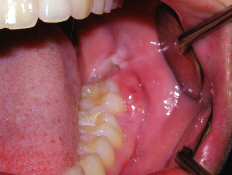
The appearance of infection is the most common reason for the immediate removal of wisdom teeth. Due to crowding that often occurs in the area of third molar eruption, food, debris, and bacteria collect in areas that are impossible to clean. This can lead to serious and life-threatening infection
Damage to lower second molar:
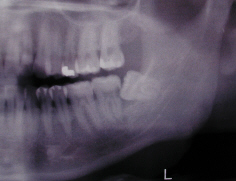
Severe decay induced by the eruption of the mesially angled third molar into the distal aspect of the adjacent second molar. The third molar was removed and the second molar required a root canal and crown. In cases where the second molar is beyond repair, removal of the second molar and replacement with a dental implant becomes necessary.
Damage to upper second molar:
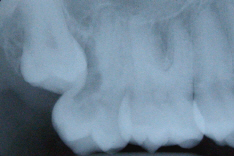 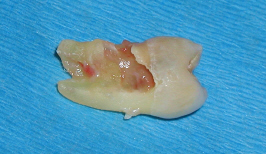
Tooth #2 (second maxillary molar pictured on the right) was rendered irreparable by the impacted wisdom tooth #1 in this 35 year old male. The patient had no symptoms until severe damage had already occurred on tooth #2. The patient will now require extensive bone grafting and a dental implant to replace the lost second molar. Hence the philosophy that you do not have to remove your wisdom teeth until problems occur was shown to be completely wrong in this patient's case.
Pathology (dentigerous cyst):
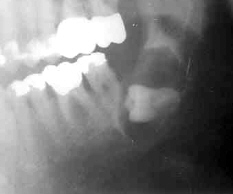
45 year-old with a dentigerous cyst resulting from an impacted lower third molar. This type of cyst tends to grow very slowly causing little to no symptoms until damage, such as severe bone loss, has occurred. The third molar was removed along with the cyst. The diagnosis of dentigerous cyst was confirmed by the pathologist. Bone grafting needed to be performed in a second surgery and a root canal had to be performed on the second molar due to the devitilization of the second molar by the pathologic process.
Pathologic fracture:
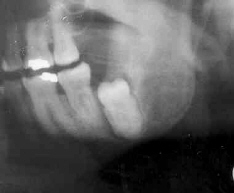
65 year-old with a chronic infection related to an impacted lower third molar. The patient refused to have her tooth removed. The delay in proper treatment resulted in progression of the deep bone infection caused by the impacted third molar. This eventually resulted in a pathologic fracture of the jaw.
Supraeruption:
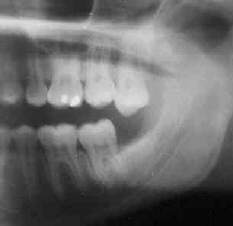
A tooth may supraerupt beyond the level of the neighboring teeth if there is no supporting tooth opposing it. In this case the upper wisdom tooth supraerupted and eroded into the soft tissues of the pharynx causing a secondary infection.
Head and neck abscess:
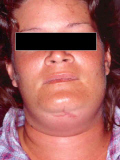
Infections caused by impacted third molars can spread into the surrounding tissues of the head and neck. In this case, the infection spread into the soft tissue spaces of the neck resulting in near collapse of the airway and a life threatening emergency. Months previous to this, the patient was advised to have her third molars removed; however, the patient failed to comply with the recommended treatment. The patient was taken to the hospital where emergency medical and surgical treatment were initiated. The patient survived and recovered well afterwards.
Ulceration and infection caused by an erupted upper third molar:
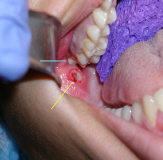 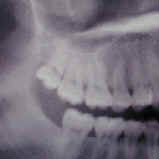
Due to lack of space, erupting upper third molars can cause ulceration in the neighboring soft tissue. In this case tooth #1 (blue line) caused a large painful ulceration (yellow line) that led to a secondary infection. The tooth was removed and the patient recovered well.
Abnormal eruption of adjacent teeth:
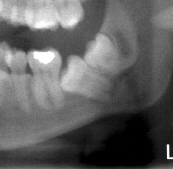
An impacted third molar may affect the normal eruption of an adjacent tooth. In this case the permanent second molar's eruption was adversely affected by the impacted third molar behind it, requiring the removal of both the third molar and the second molar. The only option for practical replacement of the second molar in this case is a dental implant.
Bone loss distal to adjacent tooth:
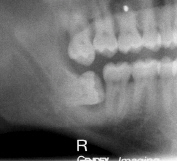
A malerupting third molar can cause severe distal bone loss to the adjacent tooth. In this case bone grafting was necessary to salvage the second molar. This added expense to the procedure and the potential for future periodontal problems involving the second molar.
back to the top»
back to Impacted Tooth
|
